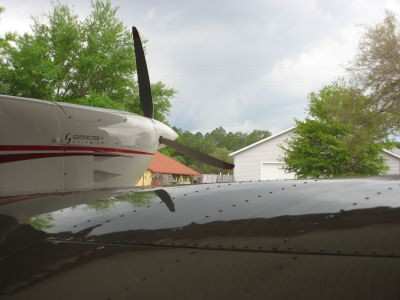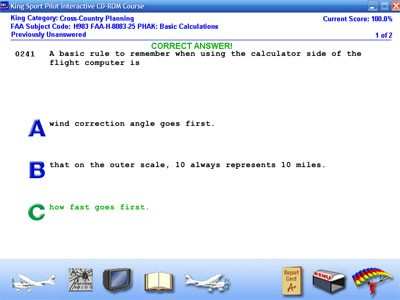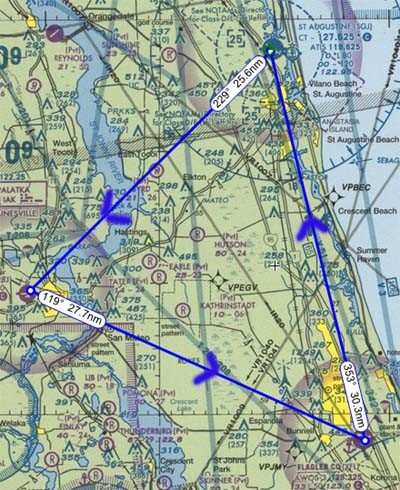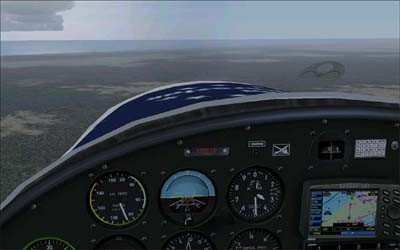"Pre-Training-Training"
by ANN Managing Editor Rob Finfrock
"You are SO gonna owe me, Bubba." It was with these seven
(vaguely ominous) words Jim told me the final arrangements had been
made for me to come down to Florida two weeks before Sun 'n Fun, to
start down the path towards earning my sport pilot rating.

"Um, how much?" I meekly asked.
"Your eternal soul," he deadpanned, but the sound of his grin
was evident over the phone.
"OK, but that's only worth a few hundred..."
Truth be known... I didn't want to know how much
Aero-News was paying to rent a plane for two weeks, when
all was said and done; paying an instructor; AND covering fuel.
(And I still don't.) At that point, all I was worried about was
making it worth all the effort. For years, I've talked about
getting a pilot license... and now, the time was quickly
approaching for me to either put up, or shut up.
So... what to do with the roughly two weeks I had before I was
destined to catch a Southwest flight to Jacksonville? Apart from
anxiously watching the clock and calendar, I had to do what I could
to prepare ahead of time.
 Some things were much
easier than others... like a quick visit to Sportys.com to
order the Florida sectionals, and the terminal charts for Orlando
and Tampa Class B.
Some things were much
easier than others... like a quick visit to Sportys.com to
order the Florida sectionals, and the terminal charts for Orlando
and Tampa Class B.
I then hauled my Jeppesen student-special pilot bag out of the
closet... and started frantically searching for my logbook, which I
had last seen just before Sebring (after a 1/2 hour searching, I
came across it on my desk... the same one I sit at everyday,
writing stories for ANN.) That was followed by a trip down the
road to my neighborhood Barnes & Noble for a copy of the 2008
FAR/AIM.
Learning From The Masters
The next -- and most important -- part of my
"pre-training-training" was taking the King Schools Sport Pilot
CD-ROM course. Way back in the early days of my flight training, I
had completed the VHS-based Jeppesen Private Pilot course... but
that was close to six years ago, with no formal ground schooling
since apart from pre-and-post-flight briefings with my
instructors.

I felt I had a pretty good idea of the various rules and
regulations... but a tune-up certainly couldn't hurt, and it would
also give me the chance to see what all the fuss was about. I'd met
John and Martha King before... but this would be the first time I'd
ever taken one of their interactive training courses.
 Like other King Schools
interactive training aids, the Sport Pilot course consists of a
number of CD-ROMs (Nine in this case, plus a setup disk and a
CD-ROM copy of the FAR/AIM) and a softcover training booklet that
roughly corresponds to the computer syllabus, and also contains the
necessary charts and graphics for reference. Installing the
software on my Dimension desktop was a breeze, and I was up and
running within about 15 minutes.
Like other King Schools
interactive training aids, the Sport Pilot course consists of a
number of CD-ROMs (Nine in this case, plus a setup disk and a
CD-ROM copy of the FAR/AIM) and a softcover training booklet that
roughly corresponds to the computer syllabus, and also contains the
necessary charts and graphics for reference. Installing the
software on my Dimension desktop was a breeze, and I was up and
running within about 15 minutes.
Working at my own pace -- completing a section or two on breaks
between writing for ANN, with a final, three-hour marathon at
the end -- I completed the entire course within four days. As I had
expected, much of it involved regulations and basic flight
principles I was already familiar with... but I resisted the urge
to "fast-forward" to the quizzes at the end of those sections, and
instead made a point of watching John and Martha's respective
presentations all the way through.
Sure enough, more often than not I did learn something new...
or, had a particular point made clearer... that I wouldn't have had
I skipped to the end. What's that line about "a good pilot is
always learning?"
There were two areas, in particular, where the Kings helped me
understand concepts that had made me uncomfortable: airspace
definitions, and cross-country planning using my six-year old, but
still pristine, E6B flight computer.
From my first flight lessons, I'd trained within the Class C
airspace over Albuquerque; at McKinney and then Grand Prairie, it
was Class D, with the DFW Class B umbrella overhead. So I was
familiar with the definitions and requirements to operate inside
those areas (and very importantly, from the start I had no fear of
operating within controlled airspace, or talking on the radio.)
Where I consistently ran into trouble, however, was when
determining Class E limits over uncontrolled airports -- what
coloration indicates a 1,200 ft. AGL ceiling, for example, versus a
700-foot ceiling? And what equipment and weather limitations were
called for? For some reason, I had a Class A-sized mental block
when it came to Class E airspace... but the Kings helped me
understand it, and more importantly, REMEMBER it. Now,
magenta-and-blue-shaded circles no longer send shivers down my
spine.

Ditto with the infamous whiz-wheel. I'd half-heartedly learned
to use it to compute true airspeed and such in the past, but I
never truly understood how all the concepts were interrelated, and
how the E6B helped figure out such problems.
I have Martha to thank for helping me understand it all; the
moment it all snapped into place was a true "Eureka!" event for me.
In fact... besides using my newfound knowledge to solve the course
problems following the lesson, it also sent me to my sectional
chart to compute my own problems, using various wind- and-air-speed
values I made up.
If it sounds like I'm now a believer in the Kings, you're
right. Needless to say, I passed the written... albeit with a lower
score than I'd wanted. I scored a 90 when I took the exam, 10 days
after I'd completed the King course. (I attribute the 10-point
lapse to test-day nerves... as I answered the missed problems
correctly when quizzed by my instructor, Jim Crone, later that same
day... but as you can probably tell, I'm still kicking myself.)

Are there things I wish the Kings did differently? Perhaps
one... though this one gripe can be chalked up to the nature of the
training, more than particular faults on John's or Martha's part.
Understandably, the Kings recycled presentations from their other
courses, including the private pilot course, in creating the
fairly-recent Sport Pilot-specific course.
One unavoidable result is that in some cases, the aspiring sport
pilot is given more information than he or she really needs for the
category. I didn't mind that a bit -- too much information is
better than too little -- but I found it somewhat humorous to sit
through a 15-minute video presentation, only to then have to answer
just one test question related to that section.
 Instead of culling those
sections to just the info a sport pilot needs to know, I'd like to
see the Kings ask a few more questions... regardless of
whether a sport pilot wannabe would actually see those questions on
the written. As a student planning to pursue more ratings down the
line, anything I can learn now for later is a plus in my book.
Instead of culling those
sections to just the info a sport pilot needs to know, I'd like to
see the Kings ask a few more questions... regardless of
whether a sport pilot wannabe would actually see those questions on
the written. As a student planning to pursue more ratings down the
line, anything I can learn now for later is a plus in my book.
In a related vein, that same "recycling" also results in some
very minor -- and mildly humorous -- production discontinuities.
For example... as the student navigates through the sport pilot
course, he or she is presented with a virtual timeline of the
Kings. An obviously younger John covers one segment; in the next,
he's a little older. When you next see him, the clock has once
again magically reversed.
Since the older segments were taken from VHS recordings, they're
also somewhat grainy compared to the more recent segments recorded
for DVD presentation. Is any of this a significant flaw? Not at
all.
And most importantly, there's one constant throughout the entire
course, no matter when a particular segment was recorded -- it's
obvious the Kings love what they do. Their enthusiasm is
contagious, and truly timeless.
"Flying" My Cross Country... At Home
With the Sport Pilot course out of the way, there was one final
area of "pre-training-training" I performed ahead of the start of
my actual lessons. I'll be the first to admit it was of dubious
educational value... but it was fun: I plotted what I expected
would be my cross-country route online, courtesy of SkyVector.com
(below)... and then "flew" that route several times
on Flight Simulator 2004.

Last year, I came across a free FS9 add-on for a Eurostar -- the
microlight equivalent of the Evektor Sportstar I was flying at the
time. While I wasn't going to be training on a SportStar this time
around, I figured the sim aircraft was close enough to the Gobosh
700S for these purposes; after all, I wasn't going for complete
virtual reality, just a rough approximation of flight times and
control responses.

(Another way to approximate "flying" an LSA on Flight Simulator:
select the default Cessna 172, and then "fly" in cruise flight at
3/4 throttle. This will result in a top indicated airspeed of about
95 knots, spot-on with most light-sport aircraft at lower
altitudes.)
As it turned out, this strategy proved more beneficial than I
had planned. When the time came for me to fly into Kay
Larkin/Palatka (28J), Flagler County (XFL) and St. Augustine (SGJ)
for real, many of the basic visual cues from Flight Simulator were
present in real-life. My actual flight times were within a few
minutes of what the sim had recorded, and Flight Simulator helped
me become familiar with runway layouts before I entered the
pattern.

Of course, not even Flight Simulator can replicate the
feeling of actually taking the controls, and performing your first
takeoff from a grass runway. Some things can only be experienced in
real-time.
Coming Thursday: Time To Fly! (Alternate Title: "RIGHT
RUDDER!")
 ANN's Daily Aero-Linx (04.15.24)
ANN's Daily Aero-Linx (04.15.24) Classic Aero-TV: 'No Other Options' -- The Israeli Air Force's Danny Shapira
Classic Aero-TV: 'No Other Options' -- The Israeli Air Force's Danny Shapira Aero-News: Quote of the Day (04.15.24)
Aero-News: Quote of the Day (04.15.24) Airborne 04.16.24: RV Update, Affordable Flying Expo, Diamond Lil
Airborne 04.16.24: RV Update, Affordable Flying Expo, Diamond Lil ANN's Daily Aero-Term (04.16.24): Chart Supplement US
ANN's Daily Aero-Term (04.16.24): Chart Supplement US












